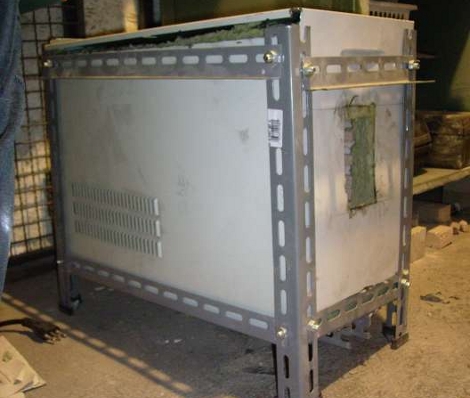
[EmcySquare] is delving into some hobby-blacksmithing by making his own knives. He needs a furnace to heat the metal, and after trying out a few different forge designs he decided to attempt an electric kiln build. The final project seen above is a box within a box. The outer shell is reclaimed using old computer cases and metal shelving brackets. Inside you’ll find a box made from fire brick, with stone-wool insulation to keep the heat where it’s supposed to be.
He cut the bricks to the right size to build the inner box, then added grooves on the inside edge witch will host the heat coils. This cutting was done with an angle grinder and [EmcySquare] notes that it kicks up an extraordinary amount of brick dust to make sure you’re wearing a respirator and goggles. Once the enclosure was ready he set out to fabricate the heat coils. Twelve meters of Kanthal A1 wire was used, shortened to a neat length by shaping coils around a 1 cm diameter wooden dowel. This prototype works but future improvements plan to add automatic temperature control through a thermocouple and a relay.
















..just like a project I’m working on — it will be a glass fusing kiln, which also requires similar heat treatment to anneal glass. I plan on using Nichrome, Kanthal, or Stainless MIG wire as an element, and TRIACs to control it.
Hi DAx,
Can you point to any information on using Stainless MIG wire as heating elements??
Any Max Temp info??
Thanks!!
Regards, Terry King
…On the Mediterranean in Italy
terry@yourduino.com
Whats the benefit of using Kanthal over nichrome?
Kanthal A1 will fire to higher temperatures where Nicrome will elements will melt.
Dexian ftw!
Most firebrick is pretty soft stuff, so an angle grinder might be overkill. I’d suggest a hacksaw. You’d probably end up with less dust, too.
Exactly Rob, I myself am a potter and have built quite a few kilns but looking for the electrical circuitry, as that’s the part I never dealt with. When dealing with the dust from bricks and fibre please make sure you ware a mask because the nasty little Silica dust can stay in the lungs of people for 2 years.. It is commonly called Silicosis.
Looks suspiciously like the box from primer :)
@dax
Nichrome has an upper limit of 2000f. Go past that and the elements will fail. Kanthal has a upper end of 2500f. You can also use iron safety wire.
PID controllers are cheap. I used one to drive a SSR to replace the old analog control on my Vulcan furnace. It has full auto tune with up to 30 steps for a program or multiple shorter programs stored in memory.
http://www.youtube.com/watch?v=S9baUZhNx0Y&feature=feedu
“..inside edge witch will host the heat coils”
Protip: witch != which
@gav I love that film *so* much.
Thanks for sharing your build. The thought never occured to me to start building something like this myself, but I just might, having read this.
I picked up knifemaking recently as well, as a hobby. I’m using RWL-34 knife steel for my current project wich needs to be heated to about 1050 degrees C (the blade will be white hot at that temp). I’m thinking about using a friends glass oven, or send it to someone using a gass-filled oven (to reduce the blade oxidizing). Have you considered using a non oxigen gas in your oven?
Again, thanks for sharing this, I may use your initial guide in the future!
Cheers,
Leonard.
Looks like a few amateur knifemakers hang out here..
I half made a knife last year, but I never put the handle on because I couldn’t heat treat it properly in our log burner.
I had vague ideas of building some sort of furnace, but with this guide I should be able to finish it.
Eventually I want to get into pattern welding, like this [link]http://maddwarfworkshop.com/knives/blackthorn.html[/link]
They call it damasteel or damast steel, i’ve made one knife using a finished fulltang blade. It’s a fairly lengthy procedure to make this yourself. You acutally smith two different kinds of steel into one layered piece. I’m not going to think about doing that myself for a long time to come, I believe it is something for very experienced smithies. But keep us posted when you do ofcourse. Especially when you brew some of the tools you will need yourself :)
That fire brick dust is one of the most toxic breathable industrial wastes on the planet. A respirator is not rated to protect you from it.
But I don’t want to be negative… I’m building one of these too. I use a hacksaw and a vaccuum and I still think I’m breathing too much dust.
It’s good to see how problems are solved from different approaches. Thanks.
Hi, I planning to make a kiln for may glass project. I need about 1200 Celcius. Can I use materials used in foundery instead of fire bricks.?Foundry furnace use plaster of paris, cement n perlite and sand.
Please anyone who is doing this please use a fume hood and exhaust the silica dust away from any person that may breath it. Find the finest filtration media still try to capture and transfer to a sealed trash bag for immediate disposal. Think asbestos then multiply by a factor of three. cheers,